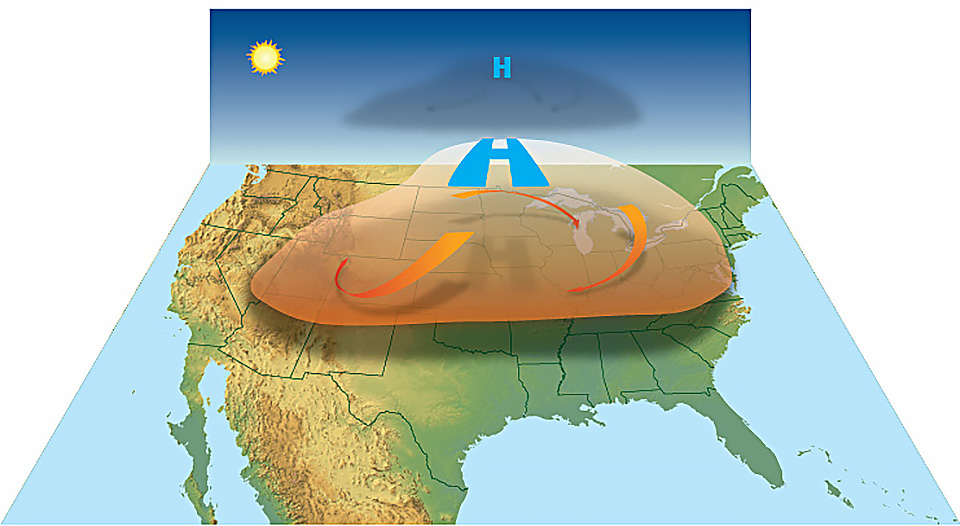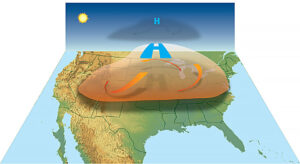A heat dome is a large area of high pressure that traps hot air, preventing it from rising and thus cooling. High-pressure systems force air downward and this air then becomes compressed, heats up, and forms a dome-shaped mass that can result in exceptionally hot and dry conditions that last for days or weeks.
Temperatures under this dome can reach dangerous levels for humans and animals and can lead to drought and wildfires
Heat domes are occurring more frequently and becoming more severe due to rising temperatures and altered weather patterns as a result of climate change.

While the terms ‘heat domes’ and ‘heat waves’ are often thought to be synonymous, heat domes are merely one of several atmospheric conditions that can cause a heat wave.
A short definition of a heat wave is an extended period of extremely hot weather, typically accompanied by high humidity, which is usually caused by warm, humid air masses from the tropics moving to an area and staying there for prolonged periods.
A number of atmospheric components come together to build such a large high-pressure system.
High-pressure systems generally create clear skies, so less sunlight is reflected and more heat is absorbed. Large areas of land and relatively dry air, as is found in plains and deserts, set the stage for heat domes to form.
As the planet warms, it can create more favorable conditions for the formation of heat domes. Also, with melting icebergs comes a change in the temperature and moisture patterns in the surrounding areas.
However, other weather systems can create the conditions for a heat dome to form as well as influence the severity and duration of a heat dome. Among the most common systems to alter the pattern of heat domes is the jet stream.
The jet stream is a somewhat narrow band of strong wind in the upper levels of the atmosphere. That blows from west to east. Under normal conditions, the jet stream has a wavelike pattern, snaking toward the north and then south and then north again. When these wanderings in the jet stream become larger, the jet stream starts slowing down and becomes stationary, thus creating conditions that are ripe for a heat dome to occur.
When the jet stream travels far north, the mass of air builds up and then sinks. As the air sinks it starts warming up, and the sinking air creates skies clear since it lowers humidity, which in turn allows the sun to heat things up on the ground. If the air close to the ground climbs over mountains and drops, it will heat up even more. These conditions led to terribly hot temperatures in the Pacific Northwest in 2021.
Heat domes normally last for several days in a region, However, heat domes can persist even longer. That happened in the Southern Plains in the U.S. in 1980, causing weeks of high summer heat and resulting in the deaths of nearly 10,000 people. The infamous Dust Bowl of the 1930s was caused by similar conditions.
You often hear meteorologists on TV talk about the heat index. The heat index is a measure of how hot a person feels when relative humidity is factored in with the actual air temperature. You should stay aware of the heat index during the summer, and take appropriate preventative measures to avoid such medical conditions as heat stroke.










